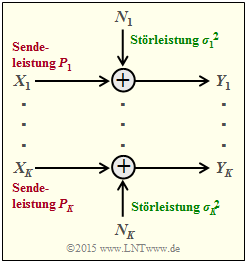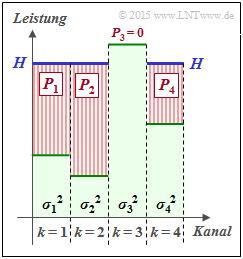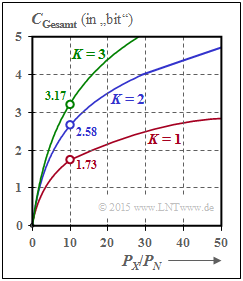Difference between revisions of "Information Theory/AWGN Channel Capacity for Continuous-Valued Input"
| Line 124: | Line 124: | ||
| − | == | + | ==Channel capacity of the AWGN channel== |
<br> | <br> | ||
| − | + | If one specifies the probability density function of the noise in the previous [[Information_Theory/AWGN–Kanalkapazität_bei_wertkontinuierlichem_Eingang#Calculation_of_mutual_information_with_additive_noise|general system model]] as Gaussian corresponding to | |
| − | [[File:P_ID2884__Inf_T_4_2_S4_neu.png|right|frame| | + | [[File:P_ID2884__Inf_T_4_2_S4_neu.png|right|frame|Derivation of the AWGN channel capacity]] |
:$$f_N(n) = \frac{1}{\sqrt{2\pi \sigma_N^2}} \cdot {\rm e}^{ | :$$f_N(n) = \frac{1}{\sqrt{2\pi \sigma_N^2}} \cdot {\rm e}^{ | ||
- \hspace{0.05cm}{n^2}/(2 \sigma_N^2) } \hspace{0.05cm}, $$ | - \hspace{0.05cm}{n^2}/(2 \sigma_N^2) } \hspace{0.05cm}, $$ | ||
| − | so | + | we obtain the model sketched on the right for calculating the channel capacity of the so-called [[Modulation_Methods/Qualitätskriterien#Einige_Anmerkungen_zum_AWGN.E2.80.93Kanalmodell|AWGN channel]] (''Additive White Gaussian Noise''). In the following, we usually replace $\sigma_N^2$ by $P_N$. |
<br clear=all> | <br clear=all> | ||
| − | + | We know from previous sections: | |
| − | * | + | *The [[Information_Theory/Anwendung_auf_die_Digitalsignalübertragung#Definition_and_meaning_of_channel_capacity|channel capacity]] $C_{\rm AWGN}$ specifies the maximum mutual information $I(X; Y)$ between the input quantity $X$ and the output quantity $Y$ of the AWGN channel. The maximisation refers to the best possible input PDF. Thus, under the [[Information_Theory/Differentielle_Entropie#Differentielle_Entropie_einiger_leistungsbegrenzter_Zufallsgr.C3.B6.C3.9Fen|power constraint]] the following applies: |
:$$C_{\rm AWGN} = \max_{f_X:\hspace{0.1cm} {\rm E}[X^2 ] \le P_X} \hspace{-0.35cm} I(X;Y) | :$$C_{\rm AWGN} = \max_{f_X:\hspace{0.1cm} {\rm E}[X^2 ] \le P_X} \hspace{-0.35cm} I(X;Y) | ||
| Line 140: | Line 140: | ||
\hspace{0.05cm}.$$ | \hspace{0.05cm}.$$ | ||
| − | : | + | :It is already taken into account that the maximisation relates solely to the differential entropy $h(Y)$ ⇒ PDF $f_Y(y)$ bezieht. Indeed, for a given noise power $P_N$ , $h(N) = 1/2 · \log_2 (2π{\rm e} · P_N)$ is a constant. |
| − | * | + | *The maximum for $h(Y)$ is obtained for a Gaussian PDF $f_Y(y)$ with $P_Y = P_X + P_N$ t, see page [[Information_Theory/Differentielle_Entropie#Proof:_Maximum_differential_entropy_with_power_constraint|maximum differential entropy under power constraint]]: |
:$${\rm max}\big[h(Y)\big] = 1/2 · \log_2 \big[2πe · (P_X + P_N)\big].$$ | :$${\rm max}\big[h(Y)\big] = 1/2 · \log_2 \big[2πe · (P_X + P_N)\big].$$ | ||
| − | * | + | *However, the output PDF $f_Y(y) = f_X(x) ∗ f_N(n)$ is Gaussian only if both $f_X(x)$ and $f_N(n)$ are Gaussian functions. A striking saying about the convolution operation is: '''Gaussian remains Gaussian, and non-Gaussian never becomes (exactly) Gaussian'''. |
{{BlaueBox|TEXT= | {{BlaueBox|TEXT= | ||
| − | $\text{ | + | $\text{Conclusion:}$ For the AWGN channel ⇒ Gaussian noise PDF $f_N(n)$ the ''channel capacity'' results exactly when the input PDF $f_X(x)$ is ''also Gaussian'': |
| − | [[File:P_ID2885__Inf_T_4_2_S4b_neu.png|right|frame| | + | [[File:P_ID2885__Inf_T_4_2_S4b_neu.png|right|frame|Numerical results for the AWGN channel capacity as a function of ${P_X}/{P_N}$]] |
:$$C_{\rm AWGN} = h_{\rm max}(Y) - h(N) = 1/2 \cdot {\rm log}_2 \hspace{0.1cm} {P_Y}/{P_N}$$ | :$$C_{\rm AWGN} = h_{\rm max}(Y) - h(N) = 1/2 \cdot {\rm log}_2 \hspace{0.1cm} {P_Y}/{P_N}$$ | ||
:$$\Rightarrow \hspace{0.3cm} C_{\rm AWGN}= 1/2 \cdot {\rm log}_2 \hspace{0.1cm} ( 1 + P_X/P_N) \hspace{0.05cm}.$$}} | :$$\Rightarrow \hspace{0.3cm} C_{\rm AWGN}= 1/2 \cdot {\rm log}_2 \hspace{0.1cm} ( 1 + P_X/P_N) \hspace{0.05cm}.$$}} | ||
| Line 155: | Line 155: | ||
| − | == | + | ==Parallel Gaussian channels == |
<br> | <br> | ||
| − | [[File:P_ID2891__Inf_T_4_2_S4c_neu.png|frame| | + | [[File:P_ID2891__Inf_T_4_2_S4c_neu.png|frame|Parallel AWGN channels]] |
Wir betrachten nun entsprechend der Grafik $K$ parallele Gaußkanäle von $X_1 → Y_1$, ... , $X_k → Y_k$, ... , $X_K → Y_K$. | Wir betrachten nun entsprechend der Grafik $K$ parallele Gaußkanäle von $X_1 → Y_1$, ... , $X_k → Y_k$, ... , $X_K → Y_K$. | ||
Revision as of 18:20, 17 April 2021
Contents
Mutual information between continuous-value random variables
In the chapter Information-theoretical model of digital signal transmission the mutual information between the two discrete-value random variables $X$ and $Y$ was given, among other things, in the following form:
- $$I(X;Y) = \hspace{-0.4cm} \sum_{(x,\hspace{0.05cm} y) \hspace{0.1cm}\in \hspace{0.1cm}{\rm supp}\hspace{0.05cm} (P_{XY}\hspace{-0.08cm})} \hspace{-0.8cm} P_{XY}(x, y) \cdot {\rm log} \hspace{0.1cm} \frac{ P_{XY}(x, y)}{P_{X}(x) \cdot P_{Y}(y)} \hspace{0.05cm}.$$
This equation simultaneously corresponds to the Kullback–Leibler distance between the joint probability function $P_{XY}$ and the product of the two individual probability functions $P_X$ and $P_Y$ :
- $$I(X;Y) = D(P_{XY} \hspace{0.05cm} || \hspace{0.05cm}P_{X} \cdot P_{Y}) \hspace{0.05cm}.$$
In order to derive the mutual information $I(X; Y)$ between two continuous-value random variables $X$ and $Y$ , one proceeds as follows, whereby inverted commas indicate a quantised variable:
- One quantises the random variables $X$ and $Y$ $($with the quantisation intervals ${\it Δ}x$ and ${\it Δ}y)$ and thus obtains the probability functions $P_{X\hspace{0.01cm}′}$ and $P_{Y\hspace{0.01cm}′}$.
- The „vectors” $P_{X\hspace{0.01cm}′}$ and $P_{Y\hspace{0.01cm}′}$ become infinitely long after the boundary transitions ${\it Δ}x → 0, {\it Δ}y → 0$ , and the joint PMF $P_{X\hspace{0.01cm}′\hspace{0.08cm}Y\hspace{0.01cm}′}$ is then also infinitely extended in area.
- These boundary transitions give rise to the probability density functions of the continuous random variables according to the following equations:
- $$f_X(x_{\mu}) = \frac{P_{X\hspace{0.01cm}'}(x_{\mu})}{\it \Delta_x} \hspace{0.05cm}, \hspace{0.3cm}f_Y(y_{\mu}) = \frac{P_{Y\hspace{0.01cm}'}(y_{\mu})}{\it \Delta_y} \hspace{0.05cm}, \hspace{0.3cm}f_{XY}(x_{\mu}\hspace{0.05cm}, y_{\mu}) = \frac{P_{X\hspace{0.01cm}'\hspace{0.03cm}Y\hspace{0.01cm}'}(x_{\mu}\hspace{0.05cm}, y_{\mu})} {{\it \Delta_x} \cdot {\it \Delta_y}} \hspace{0.05cm}.$$
- The double sum in the above equation, after renaming $Δx → {\rm d}x$ or $Δy → {\rm d}y$ , becomes the equation valid for continuous value random variables:
- $$I(X;Y) = \hspace{0.2cm} \int \hspace{-0.9cm} \int\limits_{\hspace{-0.4cm}(x, y) \hspace{0.1cm}\in \hspace{0.1cm}{\rm supp} \hspace{0.03cm} (\hspace{-0.03cm}f_{XY}\hspace{-0.08cm})} \hspace{-0.6cm} f_{XY}(x, y) \cdot {\rm log} \hspace{0.1cm} \frac{ f_{XY}(x, y) } {f_{X}(x) \cdot f_{Y}(y)} \hspace{0.15cm}{\rm d}x\hspace{0.15cm}{\rm d}y \hspace{0.05cm}.$$
$\text{Conclusion:}$ By splitting this double integral, it is also possible to write for the transinformation:
- $$I(X;Y) = h(X) + h(Y) - h(XY)\hspace{0.05cm}.$$
The joint differential entropy
- $$h(XY) = -\hspace{0.2cm} \int \hspace{-0.9cm} \int\limits_{\hspace{-0.4cm}(x, y) \hspace{0.1cm}\in \hspace{0.1cm}{\rm supp} \hspace{0.03cm} (\hspace{-0.03cm}f_{XY}\hspace{-0.08cm})} \hspace{-0.6cm} f_{XY}(x, y) \cdot {\rm log} \hspace{0.1cm} \big[f_{XY}(x, y) \big] \hspace{0.15cm}{\rm d}x\hspace{0.15cm}{\rm d}y$$
and the two differential single entropies
- $$h(X) = -\hspace{-0.7cm} \int\limits_{x \hspace{0.05cm}\in \hspace{0.05cm}{\rm supp}\hspace{0.03cm} (\hspace{-0.03cm}f_X)} \hspace{-0.35cm} f_X(x) \cdot {\rm log} \hspace{0.1cm} \big[f_X(x)\big] \hspace{0.1cm}{\rm d}x \hspace{0.05cm},\hspace{0.5cm} h(Y) = -\hspace{-0.7cm} \int\limits_{y \hspace{0.05cm}\in \hspace{0.05cm}{\rm supp}\hspace{0.03cm} (\hspace{-0.03cm}f_Y)} \hspace{-0.35cm} f_Y(y) \cdot {\rm log} \hspace{0.1cm} \big[f_Y(y)\big] \hspace{0.1cm}{\rm d}y \hspace{0.05cm}.$$
On equivocation and irrelevance
We further assume the continuous value mutual information $I(X;Y) = h(X) + h(Y) - h(XY)$ . This representation is also found in the following diagram (left graph).
From this you can see that the mutual information can also be represented as follows:
- $$I(X;Y) = h(Y) - h(Y \hspace{-0.1cm}\mid \hspace{-0.1cm} X) =h(X) - h(X \hspace{-0.1cm}\mid \hspace{-0.1cm} Y)\hspace{0.05cm}.$$
These fundamental information-theoretical relationships can also be read from the graph on the right.
This directional representation is particularly suitable for message transmission systems.
The outflowing or inflowing differential entropy characterises
- the equivocation:
- $$h(X \hspace{-0.05cm}\mid \hspace{-0.05cm} Y) =\hspace{0.2cm} -\int \hspace{-0.9cm} \int\limits_{\hspace{-0.4cm}(x, y) \hspace{0.1cm}\in \hspace{0.1cm}{\rm supp}\hspace{0.03cm} (\hspace{-0.03cm}f_{XY}\hspace{-0.08cm})} \hspace{-0.6cm} f_{XY}(x, y) \cdot {\rm log} \hspace{0.1cm} \big [{f_{\hspace{0.03cm}X \mid \hspace{0.03cm} Y} (x \hspace{-0.05cm}\mid \hspace{-0.05cm} y)} \big] \hspace{0.15cm}{\rm d}x\hspace{0.15cm}{\rm d}y\hspace{0.05cm},$$
- the irrelevance:
- $$h(Y \hspace{-0.05cm}\mid \hspace{-0.05cm} X) =\hspace{0.2cm}- \int \hspace{-0.9cm} \int\limits_{\hspace{-0.4cm}(x, y) \hspace{0.1cm}\in \hspace{0.1cm}{\rm supp}\hspace{0.03cm} (\hspace{-0.03cm}f_{XY}\hspace{-0.08cm})} \hspace{-0.6cm} f_{XY}(x, y) \cdot {\rm log} \hspace{0.1cm} \big [{f_{\hspace{0.03cm}Y \mid \hspace{0.03cm} X} (y \hspace{-0.05cm}\mid \hspace{-0.05cm} x)} \big] \hspace{0.15cm}{\rm d}x\hspace{0.15cm}{\rm d}y\hspace{0.05cm}.$$
The significance of these two information-theoretic quantities will be discussed in more detail in task 4.5Z .
If one compares the graphical representations of the mutual information for
- discrete value random variables in the section [[Information_Theory/Anwendung_auf_die_Digitalsignalübertragung#Information-theoretical_model_of_digital_signal_transmission|Information-theoretical model of digital signal transmission] continuous value random variables according to the above diagram,
the only distinguishing feature is that each „capital $H$” (entropy; larger-equal zero) has been replaced by a „non-capital $h$” (differential entropy can be positive, negative or zero) .
- Otherwise, the mutual information is the same in both representations and $I(X; Y) ≥ 0$ always applies.
- In the following, we mostly use the binary logarithm ⇒ $\log_2$ and thus obtain the mutual information in „bit”.
Calculation of mutual information with additive noise
We now consider a very simple model of message transmission:
- The random variable $X$ stands for the (zero mean) transmission signal and is characterised by the PDF $f_X(x)$ and the variance $σ_X^2$ . The transmission power is $P_X = σ_X^2$.
- The additive noise $N$ is given by the PDF $f_N(n)$ and the noise power $P_N = σ_N^2$ .
- If $X$ and $N$ are assumed to be statistically independent ⇒ signal-independent noise, then $\text{E}\big[X · N \big] = \text{E}\big[X \big] · \text{E}\big[N\big] = 0$ .
- The received signal is $Y = X + N$. The output PDF $f_Y(y)$ can be calculated with the convolution operation ⇒ $f_Y(y) = f_X(x) ∗ f_N(n)$.
- For the received power (variance) holds:
- $$P_Y = \sigma_Y^2 = {\rm E}\big[Y^2\big] = {\rm E}\big[(X+N)^2\big] = {\rm E}\big[X^2\big] + {\rm E}\big[N^2\big] = \sigma_X^2 + \sigma_N^2 $$
- $$\Rightarrow \hspace{0.3cm} P_Y = P_X + P_N \hspace{0.05cm}.$$
The sketched density functions sketched (rectangular or trapezoidal) are only intended to clarify the calculation process and have no practical relevance.
To calculate the mutual information between input $X$ and output $Y$ there are three possibilities according to the graphic on the previous subchapter drei Möglichkeiten:
- Calculation according to $I(X, Y) = h(X) + h(Y) - h(XY)$:
- The first two terms can be calculated in a simple way from $f_X(x)$ and $f_Y(y)$ respectively. The joint differentrial entropy $h(XY)$ is problematic. For this, one needs the 2D joint PDF $f_{XY}(x, y)$, which is usually not given directly.
- Calculation according to $I(X, Y) = h(Y) - h(Y|X)$:
- Here $h(Y|X)$ denotes the differential scattering entropy. It holds that $h(Y|X) = h(X + N|X) = h(N)$, so that $I(X; Y)$ is very easy to calculate via the equation $f_Y(y) = f_X(x) ∗ f_N(n)$ if $f_X(x)$ and $f_N(n)$ are known.
- Calculation according to $I(X, Y) = h(X) - h(X|Y)$:
- According to this equation, however, one needs the differential inference entropy $h(X|Y)$, which is more difficult to state than $h(Y|X)$.
$\text{Conclusion:}$ In the following we use the middle equation and write for the mutual information between the input $X$ and the output $Y$ of a message transmission system in the presence of additive and uncorrelated noise $N$:
- $$I(X;Y) \hspace{-0.05cm} = \hspace{-0.01cm} h(Y) \hspace{-0.01cm}- \hspace{-0.01cm}h(N) \hspace{-0.01cm}=\hspace{-0.05cm} -\hspace{-0.7cm} \int\limits_{y \hspace{0.05cm}\in \hspace{0.05cm}{\rm supp}(f_Y)} \hspace{-0.65cm} f_Y(y) \cdot {\rm log} \hspace{0.1cm} \big[f_Y(y)\big] \hspace{0.1cm}{\rm d}y +\hspace{-0.7cm} \int\limits_{n \hspace{0.05cm}\in \hspace{0.05cm}{\rm supp}(f_N)} \hspace{-0.65cm} f_N(n) \cdot {\rm log} \hspace{0.1cm} \big[f_N(n)\big] \hspace{0.1cm}{\rm d}n\hspace{0.05cm}.$$
Channel capacity of the AWGN channel
If one specifies the probability density function of the noise in the previous general system model as Gaussian corresponding to
- $$f_N(n) = \frac{1}{\sqrt{2\pi \sigma_N^2}} \cdot {\rm e}^{ - \hspace{0.05cm}{n^2}/(2 \sigma_N^2) } \hspace{0.05cm}, $$
we obtain the model sketched on the right for calculating the channel capacity of the so-called AWGN channel (Additive White Gaussian Noise). In the following, we usually replace $\sigma_N^2$ by $P_N$.
We know from previous sections:
- The channel capacity $C_{\rm AWGN}$ specifies the maximum mutual information $I(X; Y)$ between the input quantity $X$ and the output quantity $Y$ of the AWGN channel. The maximisation refers to the best possible input PDF. Thus, under the power constraint the following applies:
- $$C_{\rm AWGN} = \max_{f_X:\hspace{0.1cm} {\rm E}[X^2 ] \le P_X} \hspace{-0.35cm} I(X;Y) = -h(N) + \max_{f_X:\hspace{0.1cm} {\rm E}[X^2] \le P_X} \hspace{-0.35cm} h(Y) \hspace{0.05cm}.$$
- It is already taken into account that the maximisation relates solely to the differential entropy $h(Y)$ ⇒ PDF $f_Y(y)$ bezieht. Indeed, for a given noise power $P_N$ , $h(N) = 1/2 · \log_2 (2π{\rm e} · P_N)$ is a constant.
- The maximum for $h(Y)$ is obtained for a Gaussian PDF $f_Y(y)$ with $P_Y = P_X + P_N$ t, see page maximum differential entropy under power constraint:
- $${\rm max}\big[h(Y)\big] = 1/2 · \log_2 \big[2πe · (P_X + P_N)\big].$$
- However, the output PDF $f_Y(y) = f_X(x) ∗ f_N(n)$ is Gaussian only if both $f_X(x)$ and $f_N(n)$ are Gaussian functions. A striking saying about the convolution operation is: Gaussian remains Gaussian, and non-Gaussian never becomes (exactly) Gaussian.
$\text{Conclusion:}$ For the AWGN channel ⇒ Gaussian noise PDF $f_N(n)$ the channel capacity results exactly when the input PDF $f_X(x)$ is also Gaussian:
- $$C_{\rm AWGN} = h_{\rm max}(Y) - h(N) = 1/2 \cdot {\rm log}_2 \hspace{0.1cm} {P_Y}/{P_N}$$
- $$\Rightarrow \hspace{0.3cm} C_{\rm AWGN}= 1/2 \cdot {\rm log}_2 \hspace{0.1cm} ( 1 + P_X/P_N) \hspace{0.05cm}.$$
Parallel Gaussian channels
Wir betrachten nun entsprechend der Grafik $K$ parallele Gaußkanäle von $X_1 → Y_1$, ... , $X_k → Y_k$, ... , $X_K → Y_K$.
- Die Sendeleistungen in den $K$ Kanälen nennen wir
- $$P_1 = \text{E}[X_1^2], \hspace{0.15cm}\text{...}\hspace{0.15cm} ,\ P_k = \text{E}[X_k^2], \hspace{0.15cm}\text{...}\hspace{0.15cm} ,\ P_K = \text{E}[X_K^2].$$
- Die $K$ Störleistungen können ebenfalls unterschiedlich sein:
- $$σ_1^2, \hspace{0.15cm}\text{...}\hspace{0.15cm} ,\ σ_k^2, \hspace{0.15cm}\text{...}\hspace{0.15cm} ,\ σ_K^2.$$
Gesucht ist nun die maximale Transinformation $I(X_1, \hspace{0.15cm}\text{...}\hspace{0.15cm}, X_K\hspace{0.05cm};\hspace{0.05cm}Y_1, \hspace{0.15cm}\text{...}\hspace{0.15cm}, Y_K) $ zwischen
- den $K$ Eingangsgrößen $X_1$, ... , $X_K$ sowie
- den $K$ Ausgangsgrößen $Y_1$ , ... , $Y_K$,
die wir als die Gesamt–Kanalkapazität dieser AWGN–Konfiguration bezeichnen.
$\text{Vereinbarung:}$
Ausgegangen wird von Leistungsbegrenzung des Gesamtsystems. Das heißt:
Die Summe aller Leistungen $P_k$ in den $K$ Einzelkanälen darf den vorgegebenen Wert $P_X$ nicht überschreiten:
- $$P_1 + \hspace{0.05cm}\text{...}\hspace{0.05cm}+ P_K = \hspace{0.1cm} \sum_{k= 1}^K \hspace{0.1cm}{\rm E} \left [ X_k^2\right ] \le P_{X} \hspace{0.05cm}.$$
Unter der nur wenig einschränkenden Annahme unabhängiger Störquellen $N_1$, ... , $N_K$ kann für die Transinformation nach einigen Zwischenschritten geschrieben werden:
- $$I(X_1, \hspace{0.05cm}\text{...}\hspace{0.05cm}, X_K\hspace{0.05cm};\hspace{0.05cm}Y_1,\hspace{0.05cm}\text{...}\hspace{0.05cm}, Y_K) = h(Y_1, ... \hspace{0.05cm}, Y_K ) - \hspace{0.1cm} \sum_{k= 1}^K \hspace{0.1cm} h(N_k)\hspace{0.05cm}.$$
Dafür istn folgende obere Schranke angebbar:
- $$I(X_1,\hspace{0.05cm}\text{...}\hspace{0.05cm}, X_K\hspace{0.05cm};\hspace{0.05cm}Y_1, \hspace{0.05cm}\text{...} \hspace{0.05cm}, Y_K) \hspace{0.2cm} \le \hspace{0.1cm} \hspace{0.1cm} \sum_{k= 1}^K \hspace{0.1cm} \big[h(Y_k - h(N_k)\big] \hspace{0.2cm} \le \hspace{0.1cm} 1/2 \cdot \sum_{k= 1}^K \hspace{0.1cm} {\rm log}_2 \hspace{0.1cm} ( 1 + {P_k}/{\sigma_k^2}) \hspace{0.05cm}.$$
- Das Gleichheitszeichen (Identität) gilt bei mittelwertfreien Gaußschen Eingangsgrößen $X_k$ sowie bei statistisch voneinander unabhängigen Störungen $N_k$.
- Man kommt von dieser Gleichung zur maximalen Transinformation ⇒ Kanalkapazität, wenn man die gesamte Sendeleistung $P_X$ unter Berücksichtigung der unterschiedlichen Störungen in den einzelnen Kanälen $(σ_k^2)$ bestmöglich aufteilt.
- Dieses Optimierungsproblem lässt sich wieder mit dem Verfahren der Lagrange–Multiplikatoren elegant lösen. Das folgende Beispiel erläutert nur das Ergebnis.
$\text{Beispiel 1:}$ Wir betrachten $K = 4$ parallele Gaußkanäle mit vier unterschiedlichen Störleistungen $σ_1^2$, ... , $σ_4^2$ gemäß der nebenstehenden Abbildung (schwach–grüne Hinterlegung).
- Gesucht ist die bestmögliche Aufteilung der Sendeleistung auf die vier Kanäle.
- Würde man dieses Profil langsam mit Wasser auffüllen, so würde das Wasser zunächst nur in den $\text{Kanal 2}$ fließen.
- Gießt man weiter, so sammelt sich auch im $\text{Kanal 1}$ etwas Wasser an und später auch im $\text{Kanal 4}$.
Die eingezeichnete „Wasserhöhe” $H$ beschreibt genau den Zeitpunkt, zu dem die Summe $P_1 + P_2 + P_4$ der insgesamt zur Verfügung stehenden Sendeleistung $P_X$ entspricht:
- Die optimale Leistungsaufteilung für dieses Beispiel ergibt $P_2 > P_1 > P_4$ sowie $P_3 = 0$.
- Erst bei größerer Sendeleistung $P_X$ würde auch dem dritten Kanal eine kleine Leistung $P_3$ zugewiesen.
Man bezeichnet dieses Allokationsverfahren als Water–Filling–Algorithmus.
$\text{Beispiel 2:}$ Werden alle $K$ Gaußkanäle in gleicher Weise gestört ⇒ $σ_1^2 = \hspace{0.15cm}\text{...}\hspace{0.15cm} = σ_K^2 = P_N$, so sollte man natürlich die gesamte zur Verfügung stehende Sendeleistung $P_X$ gleichmäßig auf alle Kanäle verteilen: $P_k = P_X/K$. Für die Gesamtkapazität erhält man dann:
- $$C_{\rm Gesamt} = \frac{ K}{2} \cdot {\rm log}_2 \hspace{0.1cm} ( 1 + \frac{P_X}{K \cdot P_N}) \hspace{0.05cm}.$$
Die Grafik zeigt die Gesamtkapazität als Funktion von $P_X/P_N$ für $K = 1$, $K = 2$ und $K = 3$:
- Bei $P_X/P_N = 10 \ ⇒ \ 10 · \text{lg} (P_X/P_N) = 10 \ \text{dB}$ wird die Gesamtkapazität um ca. $50\%$ größer, wenn man die Gesamtleistung $P_X$ auf zwei Kanäle gleichmäßig aufteilt: $P_1 = P_2 = P_X/2$.
- Im Grenzfall $P_X/P_N → ∞$ nimmt die Gesamtkapazität um den Faktor $K$ zu ⇒ Verdoppelung bei $K = 2$.
Die beiden identischen und voneinander unabhängigen Kanäle kann man auf unterschiedliche Weise realisieren, zum Beispiel durch Multiplexverfahren in Zeit, Frequenz oder Raum.
Der Fall $K = 2$ lässt sich aber auch durch die Verwendung orthogonaler Basisfunktionen wie „Cosinus” und „Sinus” verwirklichen wie zum Beispiel bei
- der Quadratur–Amplitudenmodulation (QAM) oder
- einer mehrstufigen Phasenmodulation wie QPSK oder 8–PSK.
Aufgaben zum Kapitel
Aufgabe 4.5: Transinformation aus 2D-WDF
Aufgabe 4.5Z: Nochmals Transinformation
Aufgabe 4.6: AWGN–Kanalkapazität
Aufgabe 4.7: Mehrere parallele Gaußkanäle
Aufgabe 4.7Z: Zum Water–Filling–Algorithmus






